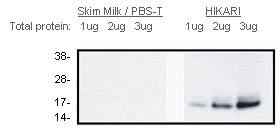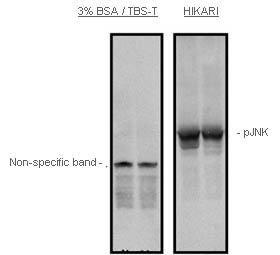Signal Enhancer HIKARI for Western Blotting and ELISA
Features

- Enhances antigen-antibody reaction: yields several- to several 10-fold increase in signal intensity
- Easily removes background: improves the specificity of your antibodies
- Works with any substrate: enhances both chemiluminescence and colorimetric detection
- Works with any membrane: enhances signal from nitrocellulose and PVDF membrane
- Ready-to-use reagent: just dilutes your antibodies with Signal Enhancer HIKARI
Product Information
Dilute your antibodies with Signal Enhancer HIKARI instead of conventional diluents such as PBS or TBS before performing your next Western blot detection protocol and witness a remarkable increase in the ability to detect the protein of interest and to eliminate undesired background.
Signal Enhancer HIKARI was developed to resolve the problems of low sensitivity and high background often encountered during procedures such as Western blotting and ELISA.
Kit Contents
Solution A for Primary Antibody
Solution B for Secondary Antibody
Applications
Detection enhancement of Rac1 with treatment of HIKARI in Western blotting
Treatment with Signal Enhancer HIKARI resulted in clear signal, whereas dilution with conventional PBS-T resulted in no signal.

Primary Ab: Anti-Rac1 (1: 1,000)
Secondary Ab: Anti-Mouse IgG-HRP (1: 2,500) Sample: Rat cortical primary neuron
Detection: ECL
Data courtesy of Dr. K. Ishizuka, Department of Neuroscience, Johns Hopkins University School of Medicine
Detection enhancement of pJNK with treatment of HIKARI in Western blotting
Treatment with Signal Enhancer HIKARI resulted in clear signal enhancement and background suppression compared with the conventional method using TBS-T.

Primary Ab: Anti-pJNK (1: 1,000)
Secondary Ab: Anti-rabbit IgG - HRP (1: 5,000)
Sample: Mouse Embryonic Fibroblast (MEF)
Detection: SuperSignal West Pico
Data courtesy of Dr. S. Matsuzawa,
Signal Transduction, NCI Cancer Center,
Burnham Institute for Medical Research
Protocols
Signal Enhancer HIKARI Procedure for Westen Blotting and ELISZA![]() (PDF 86 KB)
(PDF 86 KB)
References
- Dawn E. Barnes et al. Cytoskeleton 73, 117-130(2016)
- J Tan et al.: Biotechnology journal 10.5 (2015)
- M Koike et al.: The Journal of Veterinary Medical Science 77.9 (2015)
- Janice G.L. Tan et al. Biotechnology Journal 10, 790-800(2015)
- M. Suzuki et al. Clinical & Experimental Immunology 182, 154-161(2015)
- Hideki Ueno et al. Biochemical and Biophysical Research Communications 468, 4-11(2015)
- K Shintani-Ishida et al.: Biochimica et Biophysica Acta (BBA)-Molecular Basis of Disease 1842.5 (2014)
- R Stavniiichuk et al.: Experimental neurology 230.1 (2011)
- T Takenouchi et al.: Journal of neurochemistry117.4 (2011)
- Feng-Ming Yang et al. FEBS 276, 425-436(2009)
- Jian-Bin Wang et al. The Journal of Cell Science 122(12), 2024-2033(2009)
- Chunwei Huang et al. Reproductive Toxicology 27, 103-110(2009)
- Sawako Yamashiro et al. The Journal of Cell Science 121(Pt 23), 3867-3877(2008)
Downloads
Signal Enhancer HIKARI for Western Blotting![]() (PDF 906 KB)
(PDF 906 KB)
Ordering Information
(Storage) RT: Room temperature, A: Cool and dark, R: Refrigerator, F: Freeze



